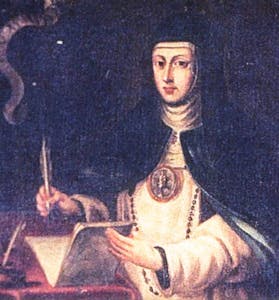This article appeared in the November 2017 issue of Texas Monthly with the headline “Putting the ‘San’ in San Angelo.”
August brought with it a most unusual guest to San Angelo: Father Stefano Cecchin, the president of Rome’s Pontifical International Marian Academy, a member in good standing of the Order of Friars Minor, and the vice postulator for the cause of Sor María de Jesús de Ágreda, a seventeenth-century nun who made her home at a convent northeast of Madrid. Cecchin is, to San Angelo bishop Michael Sis’s knowledge, the only Vatican emissary that the city has received in some time. “We’re a little off the beaten path,” he says. Sis took Cecchin to dinner at the Cork & Pig Tavern.
As the vice postulator, it is Cecchin’s responsibility to make a case for the beatification of María, which would place her one step closer to canonization, and sainthood. That requires the documentation of a miracle, and the miracles for which María is best known are her frequent appearances in West Texas, where she spread the word of the Lord to a native tribe called the Jumanos as the Spanish settled the area. Frontier evangelism was a bold avocation for a woman in 1620, made more impressive by the fact that María never left Spain.
On the European side of the Atlantic, the story goes, María experienced visions of the many hours she spent mystically transported to the northern limits of New Spain, not far from where San Angelo sits today. On the other side of the ocean, the Jumanos told missionaries about their frequent run-ins with a young and beautiful nun who wore the white habit and blue cape of María’s order. The story of the Lady in Blue, as she became known, plays a minor but significant role in the history of the settlement of Texas.
But María’s recent association with San Angelo, which led to Cecchin’s visit, is the work of the Lady in Blue Committee, a group of locals organized by Tilly Chandler, a force of nature who has been guiding festivals and cultural institutions in San Angelo for more than forty years. In 2009, Chandler, a devout Catholic, was asked by a local bishop to organize a yearly celebration of María’s life, bringing together the religious community and the descendants of the Jumanos. The event grew and grew, and in 2015 an anonymous donor pledged half a million dollars toward the installation of a bronze sculpture in a downtown park depicting María ministering to a Jumano brave and a Jumano girl.
Chandler, who is eighty years old, pursued the project with a missionary’s zeal, and as word spread, Rome came calling. Chandler invited Cecchin to stay for a week. If the priest expected a contemplative visit, he was mistaken.
“Cecchin came ten days after I had back and neck surgery—you do what you have to do,” Chandler said. “We went from eight o’clock every morning to eleven o’clock every night. I planned seven luncheons, of no more than four or five people each. We had seven dinners, mostly in nice homes, with no more than seven to eight people,” along with “two receptions, one at the country club and one at Holy Angels Church.” There were also trips to Midland and to a ranch that is home to a petroglyph, reportedly dating to the seventeenth century, portraying a nun bearing a cross.

Skeptics of the story of the Lady in Blue, like Nancy Hickerson, a former anthropologist at Texas Tech University who wrote a book on the Jumanos, point to a number of complicating factors. According to Hickerson, María seems to have told the story under some duress when asked leading questions by Friar Alonso de Benavides, a sort of “publicist for the New Mexican colony” who wanted more royal support for missionary work. For their part, the Jumanos desperately needed Spain’s help with their enemies, the Apache. Hickerson puts forth a plausible history in which Jumano leaders manufactured the story of the Lady in Blue in order to forge closer ties with the Spanish, a rare case of American natives using religion to manipulate the conqueror instead of the other way around.
Chandler, though, says there is a “preponderance of evidence that María bilocated,” using the technical term for the nun’s alleged abilities. And in contemporary San Angelo, she says, María’s memory is interceding in people’s lives in ways Chandler regards as lesser miracles. She cites, as an example, the self-identified descendants of the Jumanos, embittered by academics’ contention that the tribe long ago went extinct, who accepted Chandler’s invitation to join in the celebration of María after the tribe’s historian encountered an auspicious sign—a single bluebonnet, a flower associated with María, that had survived an ice storm on his ranch. And one of the most prominent members of the Lady in Blue Committee is the songwriter Cynthia Jordan, who, finding strength in María’s story, returned to her faith years after penning the 1983 cowgirl anthem “Jose Cuervo (You Are a Friend of Mine).” Chandler asked Jordan to compose a song about María, and Jordan ended up creating an entire album.
Next year, on the third weekend of May, Chandler’s plans will come to fruition, when María returns to San Angelo for the first time in nearly four centuries. A musical based on Jordan’s music will premiere at a local theater, a documentary on María will screen for the first time, and an international conference on María’s specialty, the study of the Holy Mary, will take place. A star-studded mass in María’s honor will be conducted on Sunday morning.
And then, the finale. On Sunday afternoon, the public will gather to watch the statue’s unveiling, and the serene visage of Sister María will once again appear on the banks of the Concho River to sanctify San Angelo’s status as a celestial city.









